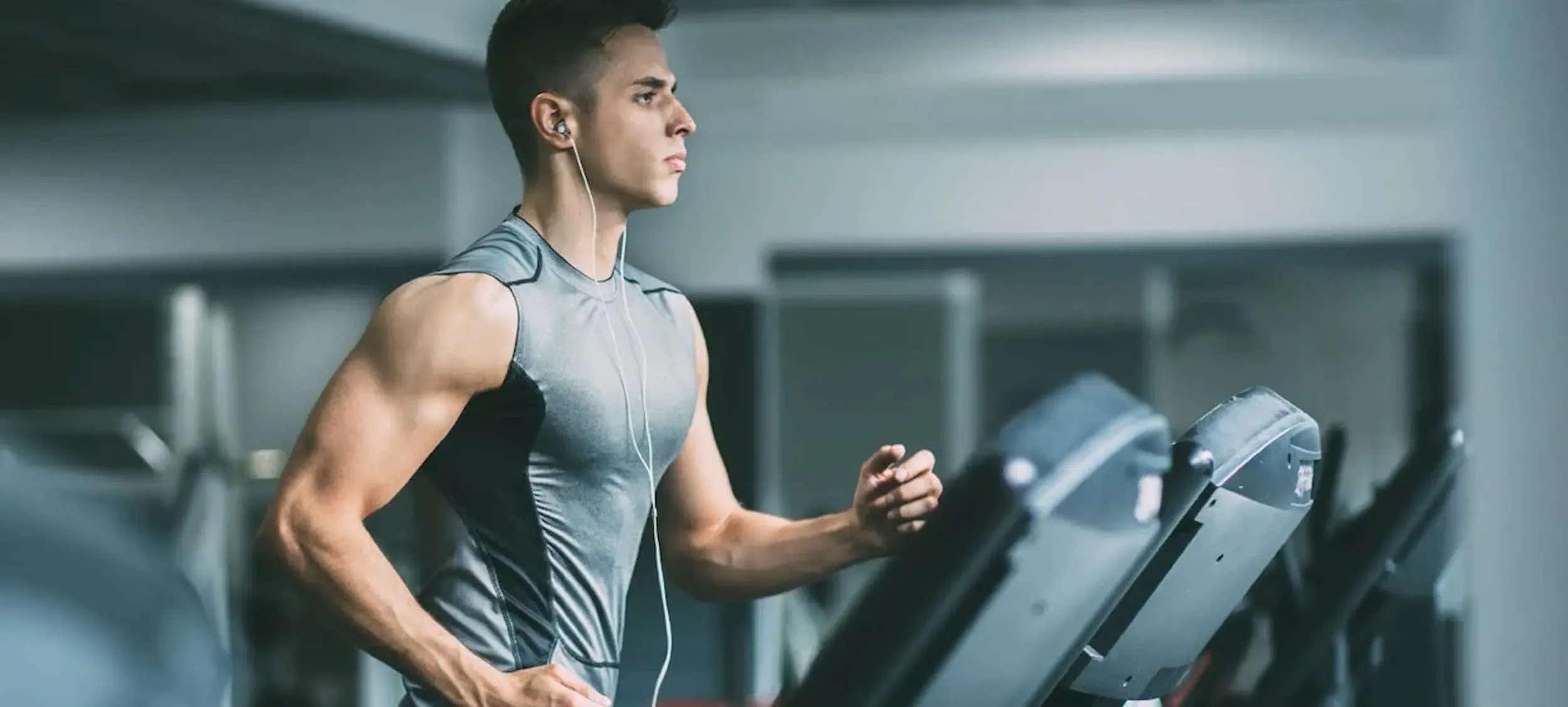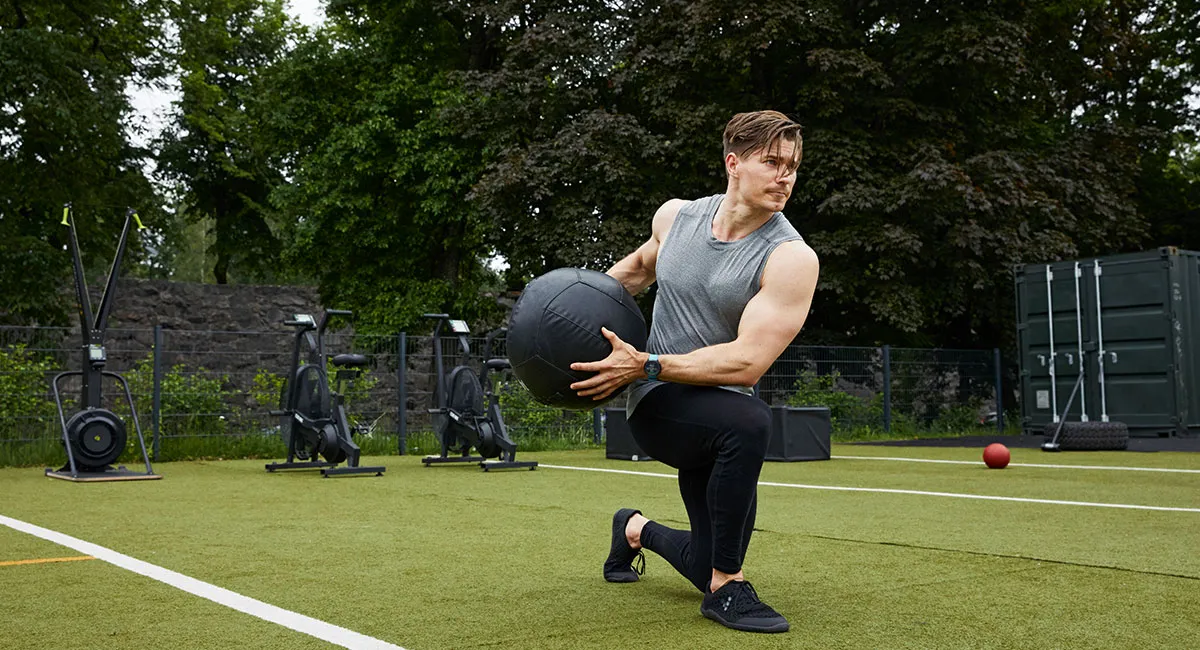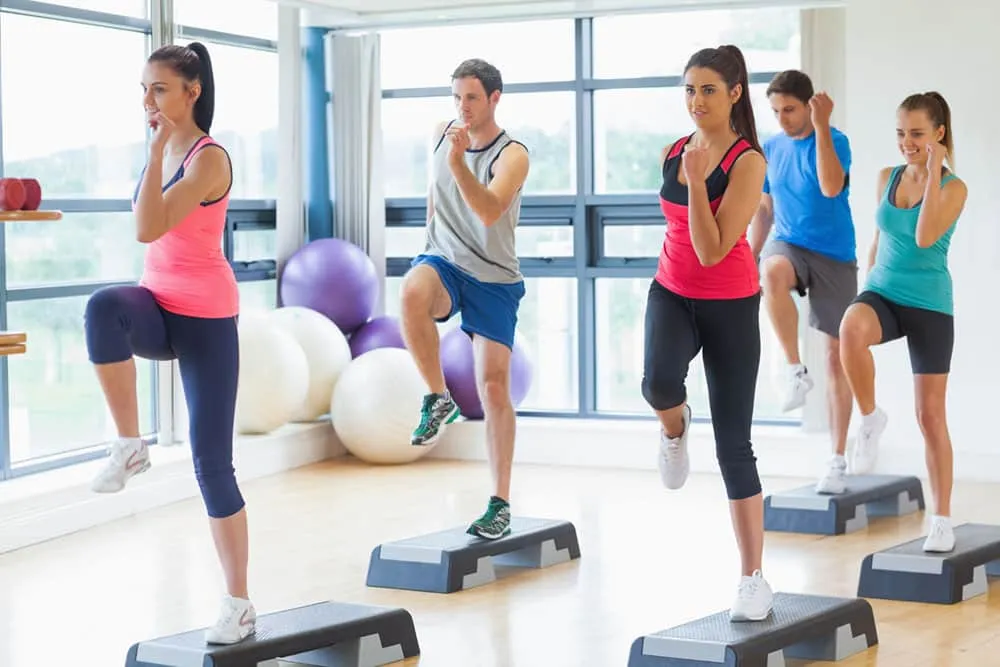What Are Cardiovascular Exercises And The Best Ones For Each Age
Discover everything about cardiovascular exercises: what they are, age-specific benefits, and the best activities to keep your heart healthy. Complete guide with practical tips.
Your heart beats about 100,000 times a day, pumping blood throughout your body without stopping. But when was the last time you actually took care of it? Cardiovascular exercises are one of the most effective ways to keep this vital organ functioning perfectly, but many people still have questions about which activities to choose and how to get started.
The truth is there's no one-size-fits-all formula. An 8-year-old has completely different needs than a 45-year-old adult or a 70-year-old senior. And that's exactly what we're going to discover together in this article: what's the best type of cardiovascular exercise for each stage of life and how you can start today, regardless of your age or current fitness level.
I'll show you everything from basic concepts to practical tips for implementing these activities into your routine safely and efficiently. Ready to take the first step toward a healthier heart?
Table of Contents
- What Are Cardiovascular Exercises
- Why Cardiovascular Exercises Are Important
- Benefits For the Heart and Body
- Cardiovascular Exercises For Children and Teens (5-17 years)
- Cardiovascular Exercises For Adults (18-64 years)
- Cardiovascular Exercises For Seniors (65+ years)
- The Best Types of Cardiovascular Exercises
- How to Start Safely
- Tips for Maintaining Consistency
What Are Cardiovascular Exercises
Cardiovascular exercises, also known as aerobic exercises or simply "cardio," are activities that make your heart beat faster and your breathing quicken. They get this name because they directly work your cardiovascular system, which includes your heart, blood vessels, and respiratory system.
During these exercises, your muscles need more oxygen to function, so your heart has to pump more blood and your lungs work more intensively. It's like a complete workout for the entire system that keeps you alive and functioning.
The main difference between cardio and other exercises lies in duration and intensity. While weight training focuses on short, intense movements, cardiovascular exercises are continuous, moderate-intensity activities that you can maintain for longer periods.
Characteristics of Cardiovascular Exercises
Cardiovascular exercises have specific characteristics that distinguish them from other modalities. First, they are rhythmic and repetitive, involving large muscle groups in continuous movements. Second, they can be maintained for extended periods without significant breaks.
Another important characteristic is that during these exercises, your body can supply enough oxygen to the working muscles. This means you're working within your aerobic capacity, unlike anaerobic exercises where you quickly become "out of breath."

Why Cardiovascular Exercises Are Important
We live in an era where heart problems are the leading cause of death worldwide, according to the World Health Organization. This isn't a coincidence - our modern lifestyle, with lots of sitting time, processed food, and constant stress, is literally killing our hearts.
Cardiovascular exercises are like "preventive maintenance" for your heart. When you practice these activities regularly, you're strengthening your heart muscle, improving circulation, and teaching your body to use oxygen more efficiently.
The impact goes far beyond the heart. These exercises help control blood pressure, reduce bad cholesterol, improve blood sugar control, and strengthen the immune system. It's like natural medicine for multiple health problems all at once.
The Heart As A Muscle
Many people don't realize that the heart is a muscle, and like any muscle, it gets stronger when exercised. When you do cardiovascular exercises regularly, your heart becomes more efficient - it can pump more blood with less effort.
This means that over time, your resting heart beats slower because each beat is more powerful. It's like upgrading from a 4-cylinder to a V8 engine - more power with lower RPMs. Well-conditioned athletes can have resting heart rates between 40-60 beats per minute, while sedentary people stay in the 70-80 range.
Benefits For the Heart and Body
The benefits of cardiovascular exercises go far beyond making you "less tired" when climbing stairs. They promote a true transformation in your body, starting with the circulatory system and spreading to all other systems.
For the cardiovascular system specifically, aerobic exercises increase the volume of blood the heart can pump with each beat, improve blood vessel elasticity, and reduce blood pressure. Your arteries become "cleaner" because exercise helps remove fat plaques that can cause blockages.
To support your cardiovascular health journey, consider incorporating quality heart-healthy supplements that can complement your exercise routine and optimize your results.
For metabolism, the benefits are impressive. During exercise, your body primarily burns fat as fuel, which helps with weight control. Additionally, even after your workout, your metabolism stays elevated for several hours, burning more calories than normal.
Mental and Emotional Benefits
Cardiovascular exercises are true natural antidepressants. During activity, your body releases endorphins, serotonin, and other neurotransmitters that improve mood and reduce stress. Many people report that a 30-minute walk or run is more effective than any anti-anxiety medication for calming the mind.
Additionally, regular practice improves sleep quality, increases self-esteem, and provides a sense of achievement that reflects in other areas of life. It's as if exercise is therapy you do while taking care of your body.
| Benefit | Effect on Body | Time to Notice |
|---|---|---|
| Mood improvement | Endorphin release | Immediate |
| Blood pressure reduction | More flexible vessels | 2-4 weeks |
| Increased lung capacity | More efficient lungs | 4-6 weeks |
| Cholesterol reduction | Improved lipid profile | 6-12 weeks |
Cardiovascular Exercises For Children and Teens (5-17 years)
Children and teens are naturally active, but unfortunately our modern society is changing that. Between video games, smartphones, and sedentary activities, many young people are losing the natural habit of moving around. That's why it's crucial to understand how to encourage cardiovascular activity in this age group.
The WHO recommendation is clear: children and adolescents aged 5 to 17 should accumulate at least 60 minutes daily of moderate to high-intensity physical activity. This might seem like a lot, but it's actually the minimum needed for healthy development.
The secret is not treating it as an obligation, but as fun. At this age, cardiovascular exercises should be playful, varied, and, most importantly, enjoyable. There's no point forcing a child to run on a treadmill if they hate it.
Best Activities For This Age Group
Traditional games are excellent disguised cardiovascular exercises. Tag, hide-and-seek, dodgeball, and soccer are activities that make the heart work intensively without the child realizing they're "exercising."
Team sports like basketball, volleyball, handball, and football are ideal because they combine cardiovascular exercise with social development. Children learn teamwork while strengthening their hearts.
Dancing is another excellent option, especially for children who don't like traditional sports. Whether it's ballroom dancing, hip-hop, ballet, or simply dancing in their room, the important thing is to move to the music.
Special Care At This Age
It's important to remember that children aren't miniature adults. They have specific physiological characteristics that must be respected. For example, children get tired more quickly than adults, but they also recover faster.
Avoid training that's too structured or overly competitive for young children. The focus should be on fun and developing basic motor skills. Excessive competition can create aversion to exercise and cause injuries.
Hydration is fundamental, especially on hot days. Children have a higher risk of dehydration than adults, so always have water available and encourage breaks to drink fluids.

Cardiovascular Exercises For Adults (18-64 years)
Adult life brings unique challenges to maintaining a cardiovascular exercise routine. Between work, family, social commitments, and financial responsibilities, finding time to exercise can seem impossible. But the truth is that this is precisely the stage of life where cardiovascular exercises become most critical for health.
The official recommendation is at least 150 minutes weekly of moderate aerobic activity or 75 minutes of intense activity. This can be divided throughout the week - for example, 30 minutes, 5 times per week, or longer sessions on fewer days.
The important thing to understand is that consistency beats intensity. It's better to walk 30 minutes every day than to run 2 hours once a week and stay inactive the rest of the week. Your heart needs regular stimulation, not sporadic "beatings."
Strategies For Busy Adults
Integrate exercise into your daily routine whenever possible. Get off the bus one stop early, use stairs instead of elevators, park farther away, walk the dog. These small moments add up throughout the day.
High-intensity, short-duration exercises can be very effective for adults with little time. HIIT (High Intensity Interval Training) workouts of 15-20 minutes can be as effective as longer sessions of moderate intensity.
Activities you actually enjoy are the ones you'll maintain long-term. If you hate gyms, don't force it. Try dancing, swimming, park walks, cycling, or any other activity that sparks your interest.
Ideal Exercises For Adults
Brisk walking is the most democratic cardiovascular exercise that exists. It requires no special equipment, can be done anywhere, and is low-impact. A 30-minute walk at moderate pace burns about 150-200 calories and provides all necessary cardiovascular benefits.
Running is more intense and time-efficient, but requires better initial conditioning. If you're sedentary, start by alternating walking with light running bursts until you develop enough endurance to run continuously.
Swimming is perfect for those with joint problems or who want a full-body workout. It's extremely low-impact and highly effective for the cardiovascular system. One hour of moderate swimming burns approximately 400-500 calories.
For those looking to set up a home gym, consider investing in quality home treadmills that can provide consistent cardio workouts regardless of weather conditions.
Cardiovascular Exercises For Seniors (65+ years)
There's a very dangerous myth that elderly people should "take it easy" and avoid exercise. The reality is exactly the opposite: cardiovascular exercises are even more important after age 65, as they help maintain independence, prevent falls, and slow the natural decline of bodily functions.
Recommendations for seniors follow the same base as younger adults: 150 minutes weekly of moderate activity or 75 minutes of intense activity. However, the approach should be more gradual and careful, always respecting individual limitations.
The great benefit of cardiovascular exercises in later life goes beyond heart health. They improve balance, strengthen bones, maintain muscle mass, and preserve cognitive functions. It's literally medicine against premature aging.
Necessary Adaptations
Start very slowly if you've been sedentary for years. Even 5-10 minutes of daily walking brings significant benefits. The important thing is to create the habit first; intensity and duration can increase gradually.
Low-impact exercises are generally safer and more comfortable. Swimming, water aerobics, walking, stationary bike, and dancing are excellent options that protect joints and reduce injury risk.
Include balance exercises along with cardio. Tai chi, gentle yoga, and walks on varied terrain help prevent falls, which are one of the main causes of serious injuries in seniors.
Recommended Exercises For Seniors
Water aerobics is almost perfect for seniors. Water supports body weight, reducing joint impact, while offering natural resistance that strengthens muscles and heart. Plus, it's fun and social.
Walking remains the gold standard. Start with 10-15 minutes on flat terrain and gradually increase. Use proper footwear and consider walking poles for greater stability.
Dancing is excellent because it combines cardiovascular exercise with cognitive stimulation and socialization. Ballroom dancing, line dancing, or even dance classes specifically for seniors are great options.
If you're in your golden years and want to start an exercise routine, books about healthy aging and fitness can provide valuable insights on how to combine exercises with proper nutrition for healthy aging.

The Best Types of Cardiovascular Exercises
Now that you understand the importance of cardiovascular exercises for each age group, let's dive into specific types of activities and their characteristics. Each modality has its advantages and may be more suitable depending on your profile, goals, and limitations.
Walking: The Universal Exercise
Walking is probably the most underestimated cardiovascular exercise that exists. Many people think it needs to be intense to be effective, but regular walking can completely transform your cardiovascular health.
A 30-minute walk at moderate pace (about 3-4 mph) burns approximately 150-200 calories, reduces blood pressure, improves mood, and strengthens the heart. Best of all: anyone can do it, anywhere, without special equipment.
To maximize benefits, vary terrain and intensity. Walk uphill, pick up the pace on flat sections, and maintain an upright posture with arms swinging naturally.
Running: Efficiency and Intensity
Running is the natural evolution of walking for those seeking greater intensity and time efficiency. In 30 minutes of moderate running, you can burn 300-400 calories and get cardiovascular benefits equivalent to an hour of walking.
But be careful with progression. If you're sedentary, don't start running. Alternate walking periods with short bursts of light running until you develop sufficient endurance. A popular program is "Couch to 5K," which in 8-9 weeks takes a sedentary person to running 5 kilometers without stopping.
Running also has higher joint impact, so invest in good running shoes and avoid running on very hard surfaces like asphalt every day. Vary between asphalt, trails, and treadmill to reduce repetitive impact.
Cycling: Fun on Wheels
Cycling combines effective cardiovascular exercise with transportation practicality. It's low-impact, primarily works the legs, and can be a fun way to explore new places.
Whether on a traditional bike or stationary bike, 45 minutes of moderate pedaling burns about 400-500 calories and provides excellent cardiovascular training. On a stationary bike, you can control resistance and speed precisely, making it easier to monitor intensity.
If you choose outdoor cycling, always use safety equipment and choose routes appropriate for your fitness level. Start with flat, short routes, gradually increasing distance and difficulty.
Swimming: The Complete Exercise
Swimming is often considered the most complete exercise that exists. It works virtually all muscle groups, is extremely low-impact, and provides excellent cardiovascular training.
One hour of moderate swimming burns 400-700 calories (depending on body weight and intensity), strengthens the heart, improves lung capacity, and tones muscles throughout the body. It's especially recommended for people with joint problems, injuries, or excess weight.
If you don't swim well, consider lessons or start with water aerobics. Water resistance provides effective training even without advanced swimming techniques.
Home Exercises: Convenience Without Excuses
It's not always possible to leave home to exercise, but that shouldn't be an excuse to skip cardiovascular training. There are several effective options that can be done in your living room.
Jump rope is incredibly effective - 10 minutes equals approximately 30 minutes of walking in terms of caloric expenditure. Dancing is another excellent option; put on your favorite music and dance for 20-30 minutes. Functional exercises like burpees, jumping jacks, and running in place are also very effective.
For those setting up a home gym, consider investing in some basic equipment from fitness gear to diversify your cardiovascular workouts.
How to Start Safely
Starting a cardiovascular exercise routine can be intimidating, especially if you've been sedentary for a long time. But with the right approach, it's possible to start safely and progressively, minimizing risks and maximizing benefits.
The first step should always be a medical evaluation, especially if you're over 40, have a family history of heart problems, or any pre-existing health conditions. A basic check-up with a stress test can identify possible limitations and guide your exercise program.
Start slowly and be patient with yourself. Many people get excited initially and overdo it, which can lead to injuries or discouragement. The secret lies in gradual progression - it's better to start with 10 minutes per day and gradually increase than to try 1 hour on the first day and quit in the second week.
Warning Signs
During any cardiovascular exercise, your body will give signals about your condition. Learn to recognize normal signs versus warning signs. It's normal to feel increased heart rate, faster breathing, sweating, and slight muscle fatigue.
Stop immediately if you feel chest pain, extreme dizziness, nausea, intense headache, or shortness of breath disproportionate to the effort. These could be signs that you're overdoing it or of a more serious problem requiring medical attention.
The practical rule is: you should be able to maintain a conversation during moderate-intensity exercises. If you're too breathless to talk, decrease the intensity.
Equipment and Preparation
Invest in good athletic shoes - it's the most important equipment for most cardiovascular exercises. Inadequate sneakers can cause injuries to feet, ankles, knees, and even the spine.
Light, comfortable clothing facilitates sweating and movement. Always have a water bottle nearby, especially in hot weather or more intense exercises.
If you plan to exercise outdoors, use sunscreen and avoid peak sun hours (10 AM to 4 PM). For home exercises, ensure you have enough space and adequate ventilation.
Building the Habit
Choose a fixed time and treat it as an unbreakable commitment to yourself. Many people have more success exercising in the morning, as it eliminates the possibility of making excuses throughout the day.
Start with small, achievable goals. Instead of "I'll exercise every day," start with "I'll walk 15 minutes, 3 times per week." When this becomes natural, gradually increase.
Record your progress somehow - smartphone app, calendar, or diary. Seeing your evolution is motivating and helps identify patterns that work for you.

Tips for Maintaining Consistency
The biggest difficulty isn't starting a cardiovascular exercise program, but maintaining it long-term. Statistics show that about 80% of people abandon their exercise resolutions within the first 3 months. But you can be different by following some proven strategies.
Vary your activities to avoid boredom. If you always walk in the same park, at the same time, at the same pace, eventually it will become monotonous. Alternate between walking, light running, dancing, swimming, or any other activity you enjoy.
Find a workout partner or exercise group. Social commitment is one of the biggest motivators for maintaining consistency. It's much harder to skip when you know someone is counting on you.
Overcoming Common Obstacles
"I don't have time" is the most common excuse, but it usually reflects priorities, not actual availability. Analyze how you spend your hours - TV time, social media, or other less priority activities can be reduced to make room for exercise.
10-15 minute workouts already bring benefits. It's better to do little consistently than a lot sporadically. Three 10-minute sessions throughout the day can be as effective as one 30-minute session.
"I don't have energy" is another common obstacle, especially at the beginning. Paradoxically, regular cardiovascular exercises increase your energy levels throughout the day. The first few weeks may be challenging, but persist - the energy will come.
Celebrate Small Victories
Recognize and celebrate your progress, no matter how small it seems. Did you manage to walk 20 minutes without stopping for the first time? Celebrate! Completed a full week of exercises? Congratulations! These moments of recognition strengthen internal motivation.
Set process goals, not just outcome goals. Instead of focusing only on "losing 10 pounds," set goals like "walk 4 times per week" or "complete 30 minutes of exercise without stopping." These goals are under your direct control and create a constant sense of achievement.
Adapting to Life Changes
Be flexible with your routine. There will be busier weeks, periods of illness, seasonal changes, or other circumstances that may affect your exercises. The important thing is to have a "plan B" and not use these situations as justification to completely abandon your routine.
Have options for different situations: home exercises for rainy days, lower-intensity activities for when you're recovering from the flu, or quicker exercises for very busy weeks.
To maintain your motivation and energy, consider supplementing your routine with wellness products that can support your active lifestyle and help you stay consistent with your cardiovascular exercise goals.
Nutrition and Cardiovascular Exercises
You can't talk about cardiovascular exercises without mentioning the importance of proper nutrition. What you eat before, during, and after exercises can make a significant difference in your performance, recovery, and long-term results.
Before exercise, the goal is to provide enough energy without causing digestive discomfort. A light meal 1-2 hours beforehand is ideal, focusing on easily digestible carbohydrates and avoiding very fatty or fiber-rich foods. A banana with some oatmeal or toast with honey are good options.
During longer exercises (over 60 minutes), it may be necessary to replenish energy and electrolytes, especially in hot climates. Water is sufficient for most people, but very intense or prolonged exercises may require sports drinks.
Consider supporting your exercise routine with quality diet and nutrition products that can help optimize your energy levels and recovery.
After exercise, focus is on recovery. Carbohydrates to replenish energy and proteins to aid muscle recovery are fundamental. A snack with protein powder and fruit, or even a turkey sandwich can be excellent options.
Hydration: Fundamental For Performance
Dehydration, even mild, can significantly reduce your cardiovascular performance and increase the risk of problems during exercise. Drink water throughout the day, not just during exercise.
A practical rule is to check your urine color - it should be light yellow. If it's dark yellow, you need to drink more water. During exercises, small frequent sips are more effective than large sporadic amounts.
For those seeking a more comprehensive approach to nutrition and exercise, books about healthy eating and fitness offer excellent insights on how to integrate proper nutrition with an active life.
Monitoring and Technology
We live in the age of smart devices, and this can be a great advantage for those who want to maintain a consistent cardiovascular exercise routine. Smartwatches, smartphone apps, and heart rate monitors can provide valuable data about your progress and help maintain motivation.
Heart rate is one of the most useful indicators during cardiovascular exercises. For moderate-intensity exercises, your heart rate should be between 50-70% of maximum heart rate (220 minus your age). For intense exercises, between 70-85%.
Free apps like Strava, MyFitnessPal, or Google Fit can track your activities, calculate calories burned, and show your progress over time. Seeing your evolution graphically can be extremely motivating.
For a more detailed analysis of your progress and cardiovascular health, consider investing in one of the best smartwatches for physical activity currently available.
Interpreting the Data
Don't become a slave to numbers, but use them as guidance tools. Some days you'll feel great but the numbers won't reflect it, other days it will be the opposite. Learn to balance objective data with subjective perceptions.
Focus on trends, not isolated days. One bad week doesn't define your progress, just as one exceptional week doesn't mean you can relax. What matters is the general direction over weeks and months.
Cardiovascular Exercises and Weight Loss
One of the main motivations for starting cardiovascular exercises is weight loss, and rightly so - they're extremely effective for burning calories and reducing body fat. But it's important to have realistic expectations and understand how the process works.
Cardiovascular exercises burn calories during and after activity. The "afterburn effect" (EPOC) means your metabolism stays elevated for hours after exercise, continuing to burn more calories than normal.
Healthy weight loss is approximately 1-2 pounds per week, which requires a caloric deficit of 500-1000 calories daily. Cardiovascular exercises can contribute significantly to this deficit, but nutrition remains the most important factor.
For a more comprehensive approach to weight loss, check out our guide on how to lose weight - everything you need to know.
Combining Cardio with Other Strategies
Cardiovascular exercises alone may not be sufficient for significant weight loss if there are no changes in diet. The famous phrase "abs are made in the kitchen" has a lot of scientific foundation.
Combining cardio with strength training can be even more effective. Strength training preserves muscle mass during weight loss, keeping metabolism higher. Learn more about the difference between cardio and weight training - which is better for weight loss.
To optimize your weight loss results, consider integrating best home workouts to lose weight fast into your cardiovascular exercise routine.
Cardiovascular Exercises for Specific Conditions
Certain health conditions require special adaptations in cardiovascular exercises, but this doesn't mean they should be avoided. In fact, in most cases, properly prescribed exercises can be an important part of treatment.
High blood pressure responds very well to regular cardiovascular exercises of moderate intensity. Studies show that aerobic exercises can reduce blood pressure by 5-10 mmHg, which may be sufficient to avoid medications in mild cases.
Type 2 diabetes also benefits enormously from cardiovascular exercises, which improve insulin sensitivity and glycemic control. Regular exercises can significantly reduce the need for medications.
After heart attacks or other cardiovascular events, supervised cardiac rehabilitation programs include progressive cardiovascular exercises as a fundamental part of treatment. Always under specialized medical supervision.
Necessary Adaptations
People with arthritis or joint problems should prefer low-impact exercises like swimming, water aerobics, or stationary bike. Walking on soft surfaces may also be suitable.
Individuals with asthma can exercise normally in most cases, but should have bronchodilators available and avoid exercises in very cold environments or with excessive pollution. Exercises in heated pools are often well tolerated.
During pregnancy, moderate-intensity cardiovascular exercises are generally safe and beneficial, but always require medical clearance and monitoring. Avoid exercises with risk of falling or abdominal impact.
Myths and Facts About Cardiovascular Exercises
Unfortunately, there are many myths about cardiovascular exercises that can confuse or discourage people who want to start. Let's clarify some of the most common ones:
Myth: "I need to run to get cardiovascular benefits". Fact: Regular walking is as effective as running for most health benefits, especially when done consistently.
Myth: "Cardiovascular exercises cause muscle loss". Fact: Moderate cardiovascular exercises preserve muscle mass. Only extremely long and intense exercises, without adequate nutrition, can cause significant muscle loss.
Myth: "You need to exercise fasting to burn more fat". Fact: While fasting exercises may use more fat for fuel during activity, total calories burned throughout the day are more important for weight loss.
Clarifying Common Confusions
"Fat burning zone" is a frequently misinterpreted concept. While lower intensities use proportionally more fat as fuel, higher intensities burn more total calories, including more fat calories in absolute numbers.
"No pain, no gain" doesn't apply to cardiovascular exercises the way many people think. Discomfort and fatigue are normal, but acute pain is neither necessary nor desirable to obtain benefits.
To further demystify concepts about diet and exercise, books about balanced approaches to health and fitness offer a balanced perspective on how to relate healthily to food and exercise.
Conclusion
Cardiovascular exercises are much more than a way to "burn calories" - they're an investment in your present and future quality of life. From children who need 60 minutes daily of activity for healthy development, to seniors who maintain independence and vitality through movement, each stage of life benefits in specific ways from aerobic exercises.
The most important thing isn't finding the "perfect" exercise, but rather finding activities you enjoy and can maintain consistently. Whether it's a morning walk, a dance class, a few minutes of jumping rope at home, or sessions at the local pool - the best cardiovascular exercise is the one you'll do regularly.
Remember that small steps lead to big changes. Even 10 minutes daily of physical activity already brings measurable benefits to your cardiovascular health. And as you develop the habit and increase your capacity, the benefits only multiply: more energy, better mood, quality sleep, greater disease resistance, and most importantly, a stronger and healthier heart.
Don't wait for Monday, next month, or the "perfect" moment to start. Your heart is beating now, working tirelessly to keep you alive. How about returning that favor with a few minutes of movement today? Start small, be consistent, and allow cardiovascular exercises to transform not just your physical health, but your relationship with your own body and well-being.
To start your journey on the right foot, consider exploring more about what to eat before and after physical activities and how the importance of sleep and how to naturally improve sleep quality can enhance the benefits of your exercises.
Finally, support your cardiovascular health journey with mindfulness practices - learn more about what is meditation, what it's for and how to start practicing. Consider incorporating meditation tools and resources to complement your physical fitness routine with mental wellness.

